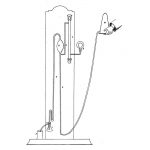Electric light bulb – Mercury vacuum pump
On the 6 January 1880 Henry Sutton invented an incandescent light bulb this was just 16 days after Thomas Edison announced his development of the light bulb.
In conjunction with the light bulb Henry invented a number of mercury vacuum pumps which aided the successful invention of his light bulb.
Henry’s mercury vacuum pump created a perfect vacuum and was used overseas in the production of light bulbs.
The principle of Henry’s vacuum pump was utilised all over the world and had become invaluable in science, medicine, transport and industry.
History:
Since 1810 many inventors had tried to make a light bulb there were a number of obstacles including finding an effective filament and a perfect vacuum.
Working alone Henry solved this by using his mercury vacuum pump and carbon manila fibre as a filament for his light bulb.
Even with a number of assistants it took Edison thousands of experiments just to find an effective filament.
Today incandescent globes have been replaced by energy efficient globes and LED lights.
The light bulb has become part of the infrastructure of everyday life and has given essential light to the whole world.
How a mercury vacuum pump works:
When the mercury container is lifted, the mercury in the tube rises closing the opening which forces the air into the tube.
Because of the partial vacuum formed the mercury will rise in the tube and prevent air coming into the tube.
By lowering the mercury container the opening will again be left open to let in a new supply of air.
The degree of vacuum obtained will depend on the number of times the container is raised and lowered.
In the production of light bulbs the air must be extracted from inside the globe for it to work.


